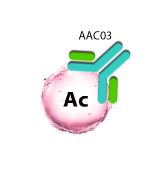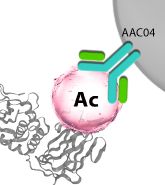Acetyl-Lysine Antibody Mouse Monoclonal (7B5A1)
Host/Isotype
Mouse / IgG2b
Clone
7B5A1
Species Reactivity
All species
Validation Data
Ac-K Antibody White Paper
IF: Ac-K Mitochondria
RRID
AB_2884029
AAC02, Anti-acetyl lysine antibody is a pan-acetyl lysine mouse monoclonal antibody that is part of the Signal-Seeker™ product line.The Anti-acetyl-lysine antibody recognizes proteins post-translationally modified by acetylation on the epsilon amine groups of lysine residues that occur on 30-50% of all proteins and in particular histones, p53, tubulin and myosin. A proprietary mixture of acetylated proteins was used to produce a highly robust antibody that has been shown to recognize a wide range of acetylated proteins in IP, WB, ChIP and IF applications. This Anti-acetyl-lysine antibody has many advantages when compared to other commercially available antibodies; in particular, it can be used to visualize acetylated mitochondrial proteins by IF.
Validated Applications
Western Blot using Acetyl-Lysine Antibody (AAC02)
Fig 1: A: Murine tissue extract, 30 μg brain extract. B: 30 μg of Cos-7 cell lysate treated with TSA and nicotinamide (+) or untreated (-). Strongly enhanced bands at 55 and 14-16 kDa in TSA-treated lysate correspond to acetylated tubulin and histone proteins, respectively. C: Titration of acetylated BSA. Lanes 1-5 contain 0.5, 0.1, 0.05, 0.01, and 0.005 ng Ac-BSA, lanes 6-7 contain 500 and 1000 ng non-acetylated BSA, respectively. AAC02 was used at a 1:500 dilution following the recommended western blot protocol.
To see the full Western blot comparison, see the Optimized Protocols or the product datasheet.
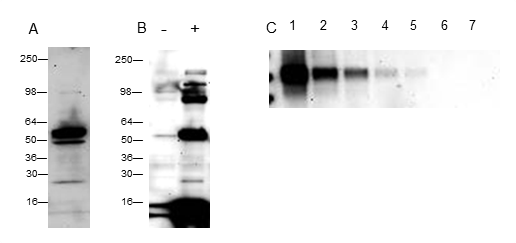
Immunoprecipitation using Acetyl-Lysine Antibody
Fig 2: Cos-7 cells were either treated (+) or untreated (-) with TSA (1 μM) and nicotinamide (1 mM) for 6 hours. Cell lysates were prepared in BlastR buffer and filter system and 1 mg of lysate per reaction was used for IP of acetylated proteins. 20 μl of AAC02 was used per IP reaction. Western blots of immunoprecipitated proteins were developed using AAC03-HRP at 1:3000 dilution.
To see the full Immunoprecipitation comparison, see the Optimized Protocols or the product datasheet.
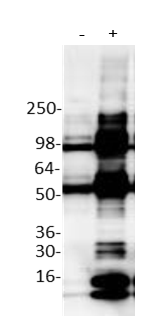
To see the full Immunofluorescence protocol, see the Optimized Protocols or the product datasheet.
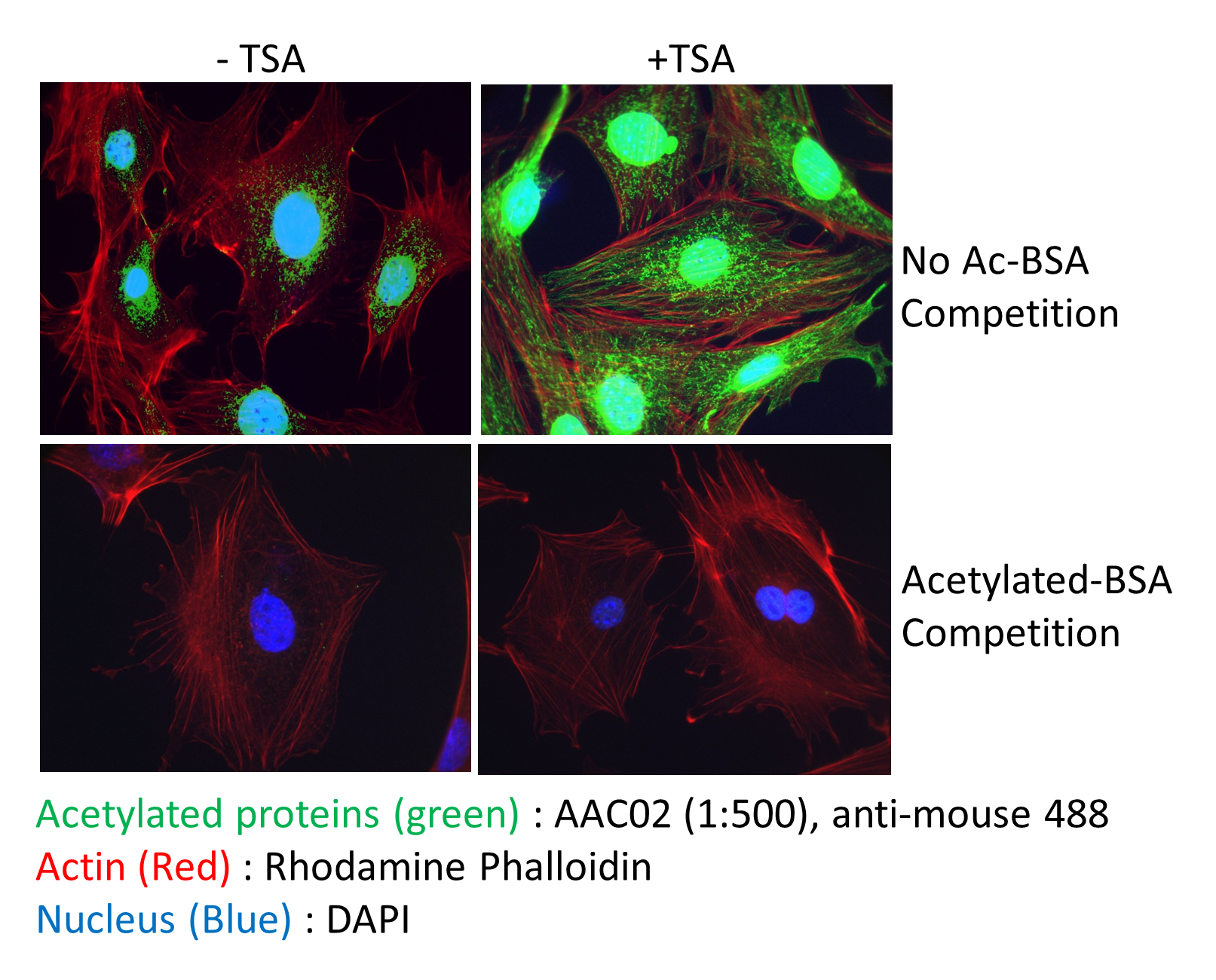
To see the full Immunofluorescence protocol, see the Optimized Protocols or the product datasheet.
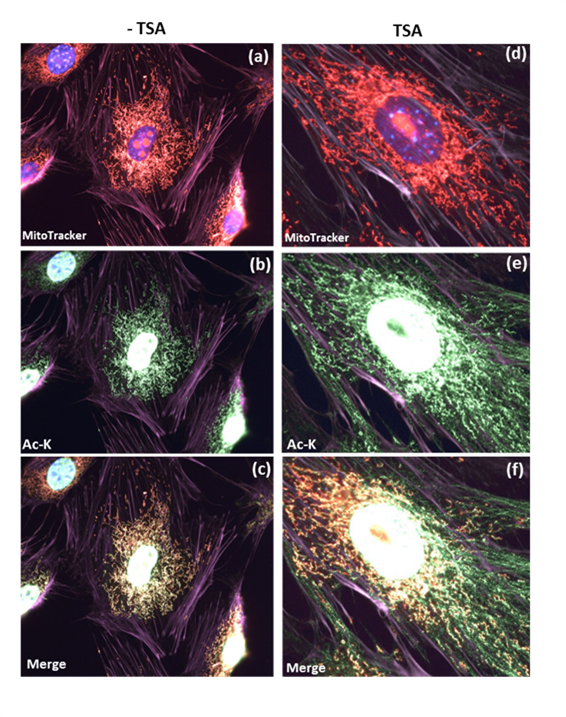
To see the recommended ChIP protocol, see the Optimized Protocols or the product datasheet

Protein Acetylation Background
Acetylation of proteins can occur as a co-translational or post-translational modification (PTM) (1). Co-translational acetylation occurs at the N-terminal of approximately 85% of mammalian proteins, it is irreversible and is thought to be important in protein stability, localization and synthesis (1). Post-translational acetylation occurs on the epsilon amino group of lysine residues as a reversible and highly dynamic PTM that is known to be a key regulator in multiple cellular events, including chromatin structure, transcription, metabolism, signal transduction and cytoskeletal regulation (2-3). To date over 4,000 proteins have been identified as targets for PTM acetylation which is comparable to phosphorylation in cellular prevelance (3). Antibody AAC01 detects acetyl lysine PTMs.
References
1 Bogdan P. and Sherman F. 2002. The diversity of acetylated proteins. Genome Biol. 3 (5): reviews 0006.
2 Lundby A. et al. 2012. Proteomic analysis of lysine acetylation sites in rat tissues reveals organ specificity and cellular patterns. Cell Reports 2:419-431.
3 Sadoul K. et al. 2010. The tale of protein lysine acetylation in the cytoplasm. J. Biomed. Biotech. 2011:1-15.
4 Golemis EA et. Al, Protein-Protein Interactions, CSHLP, 2005, p67
For more information contact: signalseeker@cytoskeleton.com
Associated Products:
Signal-Seeker™ Acetyl-Lysine Detection Kit (Cat. # BK163)
Signal-Seeker™: BlastR™ Rapid Lysate Prep Kit (Cat. # BLR01)
Signal-Seeker™ Acetylation Affinity Beads (Cat.# AAC04-beads)
Visit our Signal-Seeker™ Tech Tips and FAQs page for technical tips and frequently asked questions regarding this and other Signal-Seeker™ products click here
If you have any questions concerning this product, please contact our Technical Service department at tservice@cytoskeleton.com



